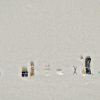WANG JINGYUN
Blueprint
18 April – 8 September 2024
Venice, Ca’ Pesaro – International Gallery of Modern Art, Project room
Curated by Marina Bastianello
In the traditional sense, ”Blueprint” is a technical drawing used to accurately communicate the details of an architectural or mechanical design, usually presented with a blue background and white lines.
In this exhibition, ‘Blueprint’ symbolises the basic design of life, just as blueprints define the form and function of a structure in architecture and engineering. The artist uses 23 pairs of chromosomes as letters and words to create a new asemic script based on an analysis of the rhythm, harmony and silent pauses of classical poetry. Through the combination of carefully selected, constructed and arranged objects, he weaves a visual grammar that symbolises the composition and origin of life, the transmission of information and genetic codes, describing a new hybrid and unknown life, but closely related to the existence of human beings. This work explores the fundamental questions of identity, inheritance, destiny and life itself.
Like the myth of the three goddesses of destiny in Greek mythology, who control fate by weaving the thread of life, in the same way, the artist weaves this ‘new life’ by symbolically transcribing the very meaning of its existence.
In addition to personally selecting the physical properties of the objects used to compose the genetic make-up of this new entity, a series of symbologies linked to the various elements are taken into consideration, such as the material, the dynamics of the relationship between the objects themselves, time and space, which will influence conservation and perishability, but also what has already happened and is therefore part of the object’s history. It is a selection work articulated on several levels, from the large-scale collection to the selection in detail, to the search for a compatible pair according to dynamics of contrast or affinity, which, in any case, according to the artist’s view, respect the intrinsic essential nature of the pair of objects created.
Each pair represents a chromosome or the ”words” of a text that does not actually exist; they are like a trace, the shadow of a composition of which there is no transcript because it was not generated with lexical meaning.
The interrelationships between these words represent how different genes influence each other and control the biological properties of each creature and at the same time, reflect the complexity and diversity of biological evolution. By recombining, transforming and linking chromosomal materials, the boundaries between human and non-human blur, questioning the nature of humanity and life. ‘Blueprint’ is a changing design. This quest is not limited to human beings, but also explores our origins, our identity and the infinite possibilities of future life. The audience here is not just a performer, its participation becomes the reproduction and reshaping of genetic memory, fluid and invisible in the work.
_
Wang Jingyun was born on 26 August 1996 in Neijiang, Sichuan, China.
In 2021, he obtained a master’s degree in NTA (New Art Techniques) from the Accademia of Fine Arts in Venice. In 2021 he won the visual poetry category of the Artefici del nostro tempo competition by the Venice Municipality and in 2022 he achieved the first place for the discipline of glass design.
In his works, he tries to pursue a metaphorical and seemingly non-existent, blurring the boundaries between concepts, images and matter. He explores the dilemma of time, the contradictory nature of everyday life and the inevitability of death, expressing an obsession with the fragility and finality of things. These themes are not just states or outcomes, but evidence of the cycle of the universe. Presented in a poetic and emotional manner, his exploration becomes a collection of fragments of reality, individual experience, environment and time, extracting new stories and meanings from easily realised products, industrial debris and natural things. His works consist mainly of cross media installations and poetry experimental. His works have been exhibited in China, France, Spain, Italy, Greece and South Korea.

